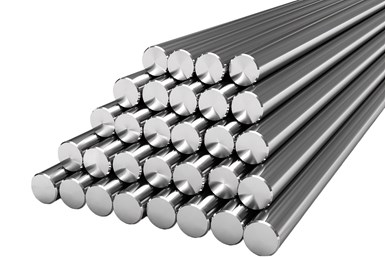Turned and Polished Steel Barstock: How It Is Manufactured, How It Impacts Your Shop
Understanding the benefits provided by turned and polished steel barstock and its differences from cold-drawn steel barstock can help you and your team avoid unexpected performance issues.
#pmpa
Turned and polished steel bars have the mechanical properties of hot-rolled steel bars, but exhibit a greatly improved surface finish and dimensional accuracy. Turned and polished steel bars are produced from hot- rolled steel bars that have been descaled, straightened and had stock removal taken in a turning machine before final polishing. This minimizes any surface imperfections and ensures dimensional conformance with ASTM A 108 Table A1.1 (carbon grades) and Table A1.2 (alloy grades.) These bars are held to the same requirements for straightness (Table A1.4) as cold drawn. Turned and polished bars are relatively free from residual stresses, compared to cold-drawn, non-stress-relieved steel bars, due to the lack of cold-working strain.
The stock removal is taken from the outside diameter of the bar by tools held in rotating cutting heads as the bar is fed through the machine. A second station presses hardened steel rolls against the newly turned surface to smooth the surface and impart a bright finish. Turned and polished steel bars cost more than hot-rolled steel bars because of the cost of their processing as well as the yield loss resulting from the stock removal (chips removed) from the turning operation.
Featured Content
The turning and polishing process results in a bright finish relatively free of seams, slivers and other imperfections, but does not enhance mechanical properties because there is no cold work applied. The turned and polished bars are then protected with a rust preventive prior to packaging and labeling for shipment.
In contrast, to produce cold-drawn steel bars, hot-rolled steel bars, either in cut lengths or in coils, are first cleaned by shot blasting or acid pickling to remove the hard abrasive oxide scale on the surface.
Then they are pulled through a carbide die in the presence of high-pressure lubricants which reduces the bar’s cross section. This process is called cold work (no heat is added in the process).
The cold work trues up shape and holds diameter size to a very tight tolerance. The process also improves strength (increasing both yield and tensile strength) and hardness, while reducing ductility (% elongation and % reduction in area). The drawn bar is then straightened and cut to length with further testing for surface imperfections, if specified.
Bars then have rust preventive applied and are packaged and labeled for shipment.
The difference between turned and polished and cold- drawn steel bars is two-fold: (1) there is no cold-working enhancement of mechanical properties in turned and polished steel bars which means no improvement in machinability, and (2) turned and polished steel bars have had stock removal taken to minimize surface imperfections, cold-drawn steel bars have had no stock removal taken.
Why Choose Turned and Polished Bars?
The turning operation adds value by improving the quality of the hot rolled, as rolled steel bars, by minimizing decarburization, seams, slivers and any other surface imperfections. As no cold work is performed, the mechanical properties of the turned and polished bars are those of the hot-rolled steel bars used as their feedstock.
The process of cold drawing is done at ambient temperatures, increasing mechanical properties by a process called cold work. This cold work increases yield strength, substantially; the tensile strength somewhat; as well as the hardness. At the same time, the ductility is reduced. These changes improve the steel’s machinability.
Turned and polished bars are therefore a less suitable choice for machining, as the lack of cold work makes them less machinable than a comparable cold-drawn bar. Turned and polished bars are used in applications requiring a minimum of machining such as shafting and power take off applications where little machining to produce the part are required.
Tolerances for both turned and polished and cold- drawn steel bars are unilateral (to the minus only) from the specified size. Out of roundness in these products is one-half the size tolerance, per footnote D for both tables. The chemistry which identifies the material as a particular grade as well as other requirements such as product analysis tolerances and grain size can be found in ASTM A 29, Specification for General Requirements for Steel Bars, Carbon and Alloy, Hot Wrought, which is included by reference in ASTM A 108.
The reasons to select a turned and polished steel bar are few but compelling:
- The hard abrasive scale has been removed — the product is bright, smooth and has a workmanlike finish.
- The turning operation removes the outer layers of the hot-rolled steel bar, minimizing decarburization and the presence of seams, slivers, laps and other surface imperfections.
- The turning and polishing operation also ensures dimensional conformance and an improved surface finish. (RMS 20 is typical)
- The tight dimensional and out-of-round tolerance may result in a reduction in processing needed.
- The straightness (lack of runout) as well as the better concentricity and dimensional tolerance makes turned and polished bars ideal for shafting applications.
- Standard grades and sizes are widely stocked and available for prompt delivery.
What Don’t You Get With Turned and Polished Steel Bars?
Enhanced mechanical properties. And, because of that, lower machinability. As no cold work has been imparted to the material, the existing mechanical properties of the starting hot-rolled steel bar carry over into the turned and polished bar. This results in lower machinability than found in a cold-drawn bar. What you do get is similar dimensional and straightness tolerance, bright smooth finish, relative freedom from decarburization, seams, slivers and other surface imperfections. Turned and polished bars are often the choice for safe reliable transmission of torque and mechanical power. For applications where resistance to wear is required, turned and polished bars can have their surface enhanced by hardening treatment.
Final Word — “Cold Finished” Steel Bars
Both turned and polished and cold-drawn steel bars are “cold-finished” steel bars. They are processed at ambient temperatures. So, when someone uses the term “cold-finished steel bar” it is important to determine exactly what they mean by cold finished. For best machinability — and enhanced mechanical properties — cold drawing is indicated. Turned and polished is often the best choice for shafting and other applications requiring little machining but having a high need for surface and dimensional integrity.
Read More Articles from PMPA:
- Roles of Women in Manufacturing Series: Marketing Manufacturing — Debra Beevers and Courtney Ortner
- Craftsman Cribsheet No. 117: A Little Dab to Prevent Machine Downtime
About the Author
Miles Free III
Miles Free III is the PMPA Director of Industry Affairs with over 40 years of experience in the areas of manufacturing, quality, and steelmaking. He helps answer “How?, “With what?” and “Really?” Miles’ blog is at pmpaspeakingofprecision.com; email – mfree@pmpa.org; website – pmpa.org
RELATED CONTENT
-
Precision Ground Barstock: How It Is Manufactured, Benefits to Your Shop
Understanding the benefits provided by precision centerless ground barstock can help you avoid false economy and optimize the work you quote by maximizing benefits to your manufacturing process and customer.
-
Cold-Drawn Steel Barstock: How It Is Manufactured, Benefits to Your Shop
Understanding the benefits provided by cold-drawn steel barstock can help you optimize the work you quote by maximizing benefits to your manufacturing process and customer.
-
The Value of Auto Adjust Magazine Bar Feeders
This bar feeder is designed to offer the flexibility to enable CNC turning centers to perform short-run work that would otherwise require frequent setups over a range of barstock diameters.







